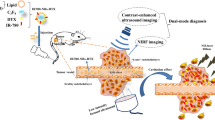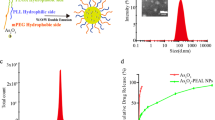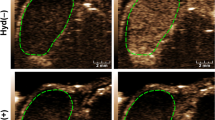Abstract
We examined whether sonoporation enhanced by a contrast agent (BR14) was effective in gene therapy for hepatocelluar carcinoma (HCC). Human hepatic cancer cells (SK-Hep1) and plasmid cDNAs expressing green fluorescent protein (GFP), interferonβ (IFNβ), and LacZ were used. In vitro, SK-Hep1 cell suspensions with DNA and BR14 were sonoporated. Expressions of every plasmid cDNA and the antitumor effect of IFNβ were analyzed. In vivo, GFP and IFNβ genes with BR14 were directly injected into subcutaneous tumors using SK-Hep1 in nude mice, and transcutaneous sonoporation of the tumors was performed. GFP gene transfections and tumor diameters after IFNβ gene transfection were examined. In vitro, no SK-Hep1 cells were transfected without sonication, whereas transfections were successful after sonication with BR14. Antitumor effect of IFNβ gene transfection by ultrasound (US) and with BR14 was revealed. In vivo, the SK-Hep1 cells expressed GFP, and the IFNβ gene transfection by US with BR14 reduced tumor size significantly. In conclusion, gene therapy with sonoporation enhanced by a contrast agent may become a new treatment option for HCC.
This is a preview of subscription content, access via your institution
Access options
Subscribe to this journal
Receive 12 print issues and online access
$259.00 per year
only $21.58 per issue
Buy this article
- Purchase on Springer Link
- Instant access to full article PDF
Prices may be subject to local taxes which are calculated during checkout







Similar content being viewed by others
References
Yamashita Y, Shimada M, Tachibana K, et al. In vivo gene transfer into muscle via electrro-sonoporation. Hum Gene Ther. 2002;13:2079–2084.
Allan L, Axel FB, Sheila EF, et al. Ultrasound enhances reporter gene expression after transfection of vascular cells in vitro. Circulation. 1999;99:2617–2620.
Evan CU, Thomas PM, Robert HS . Ultrasound enhances gene expression of liposomal transfection. Invest Radiol. 1997;32:723–727.
Leonhard M, Srinivas S, Seung-kew Y, et al. Gene therapy of hepatocellular carcinoma in vitro and in vivo in nude mice by adenoviral transfer of the Escherichia coli purine nucleoside phosphorylase gene. Hepatology. 2000;31:606–614.
Miguel B, Guillermo M, Guillem G, et al. Gene therapy of orthotopic hepatocellular carcinoma in rats using adenovirus coding for Interleukin 12. Hepatology. 2001;33:52–61.
Terazaki Y, Yano S, Yuge K, et al. An optimal therapeutic expression level is crucial for suicide gene therapy for hepatic metastatic cancer in mice. Hepatology. 2003;37:155–163.
Maria TV, Andres HG, Michael I, et al. Impact of preimmunization on adenoviral vector expression and toxicity in a subcutaneous mouse cancer model. Mol Ther. 2002;6:342–348.
Nakashima M, Tachibana K, Iohara K, Ito M, Ichikawa M, Akamine A . Induction of reparative dentin formation by ultrasound-mediated gene delivery of growth/differentiation factor 11. Hum Gene Ther. 2003;14:591–597.
Taniyama Y, Morishita R, Aoki M, et al. Development of safe and efficient novel nonviral gene transfer using ultrasound: enhancement of transfection efficiency of naked plasmid DNA in skeletal muscle. Gene Therapy. 2002;9:372–380.
Victor JD, Michael JM, Ryuichi M, Yasufumi K . Fusigenic viral liposome for gene therapy in cardiovascular diseases. Proc Natl Acad Sci USA. 1996;93:11421–11425.
Marshall E . Gene therapy death prompts review of adenovirus vector. Science. 1999;286:2244–2245.
Evan CU, Evan H, Mani V, Thomas M . Gene delivery using ultrasound contrast agents. Echocardiography. 2001;18:355–361.
Patrick B, Valerie PC, Adolfo G, et al. Naked DNA Injection for liver metastases treatment in rats. Hepatology. 2002;35:1144–1152.
Tachibana K, Uchida T, Ogawa K, Yamashita N, Tamura K . Induction of cell-membrane porosity by ultrasound. Lancet. 1999;353:1409.
Shiping B, Brian DT, Douglas LM . Transfection of a reporter plasmid into cultured cells by sonoporation in vitro. Ultrasound Med Biol. 1997;23:953–959.
Shiping B, Brian DT, Richard AG, Douglas LM . In vivo transfection of melanoma cells by Lithotripter shock waves. Cancer Res. 1998;58:219–221.
Marcus F, Craig D, Robert FM, Taylor DL . Measurement of cytoplasmic pH in Dictyostelium discoideum by using a new method for introducing macromolecules into living cells. Eur J Cell Biol. 1986;40:242–247.
Ka-yun N, Yang L . Therapeutic ultrasound: its application in drug delivery. Med Res Rev. 2002;22:204–223.
Mark W, Junru W, Jen-Fu C . Experimental study of optison concentration on sonoporation in vitro. Ultrasound Med Biol. 2000;26:1169–1175.
Mark W, Junru W, Jen-Fu, C . Ultrasound-induced cell lysis and sonoporation enhanced by contrast agents. J Acoust Soc Am. 1999;105:2951–2957.
Evan CU, Evan H, Mani V, Terry OM, Thomas M . Local drug and gene delivery through microbubbles. Prog Cardiovasc Dis. 2001;44:45–54.
Takahashi M, Sato T, Sagawa T, et al. E1B-55K-deleted adenovirus expressing E1A-13S by AFP-enhancer/promoter is capable of highly specific relation in AFP-producing hepatocellular carcinoma and eradication of established tumor. Mol Ther. 2002;5:627–634.
Alshad SL, Betty C, Jian MN, et al. Anti-tumor efficacy of human angiostatin using liver-mediated adeno-associated virus gene therapy. Mol Ther. 2004;9:56–66.
Katsunori S, Oliver E, Chryssanthi K, Yun-Sheng T, Savio LCW . Oncolysis of multifocal hepatocellular carcinoma in the rat liver by hepatic artery infusion of vesicular stomatitis virus. Mol Ther. 2004;9:368–376.
Tada H, Maron DJ, Choi EA, et al. Systemic IFN-β gene therapy results in long-term survival in mice with established colorectal liver metastases. J Clin Invest. 2001;108:83–95.
Volker S, Miguel B, Lin W, et al. Adenovirus-mediated CD40 ligand gene therapy in a rat model of orthotopic hepatocellular carcinoma. Hepatology. 2001;34:72–81.
Ruian X, Xueying S, Lai-Yin T, et al. Long-term expression of angiostatin suppresses metastatic liver cancer in mice. Hepatology. 2003;37:1451–1460.
Ben-Gary H, Robin LM, Todd R, Martin LL, Ronald GC . Systemic interleukin-6 responses following administration of adenovirus gene transfer vectors to humans by different routes. Mol Ther. 2002;6:287–297.
Sorin A, Ulrich ML, Irina S, et al. Adenoviral gene transfer of tumor necrosis factor-related apoptosis-inducing ligand overcomes an impaired response of hepatoma cells but causes severe apoptosis in primary human hepatocytes. Cancer Res. 2003;63:2369–2372.
Patricia Y, AR Davis, MJ Hicks, NS Templeton, Benner MK . Liposomal enhancement of the antitumor activity of conditionally replication-competent adenoviral plasmids. Mol Ther. 2004;9:489–495.
Kim KS, Kim HS, Park JS, Kwon YG, Park YS . Inhibition of B16BL6 tumor progression by coadministration of recombinant angiostatin K1-3 and endostatin genes with cationic liposomes. Cancer Gene Ther. 2004;11:441–449.
Moret-Tatay I, Diaz J, Marco FM, Crespo A, Alino SF . Complete tumor prevention by engineered tumor cell vaccines employing nonviral vectors. Cancer Gene Ther. 2003;10:887–897.
van Zanten J, Doornbos-Van der Meer B, Audouy S, Kok RJ, de Leij L . A nonviral carrier for targeted gene delivery to tumor cells. Cancer Gene Ther. 2004;11:156–164.
Hajri A, Wack S, Lehn P, et al. Combined suicide gene therapy for pancreatic peritoneal carcinomatosis using BGTC liposomes. Cancer Gene Ther. 2004;11:16–27.
Sakurai F, Terada T, Maruyama M, et al. Therapeutic effect of intravenous delivery of lipoplexes containing the interferon-beta gene and poly I: poly C in a murine lung metastasis model. Cancer Gene Ther. 2003;10:661–668.
Matus S, Frank CM, Richard EC, Claudia Z, Isaiah JF, Michael A . Bone marrow-derived mesenchymal stem cells as vehicles for interferon-β delivery into tumors. Cancer Res. 2002;62:3603–3608.
Takaoka A, Hayakawa S, Yanai H, et al. Integration of interferon-α/β signalling to p53 responses in tumour suppression and antiviral defense. Nature. 2003;424:516–523.
Scott MF, Rajagopal R, Munish S, Anupama M, Andrea KJ, Aizen JM . The role of cytokines in mediating the bystander effect using HSV-TK xenogeneic cells. Cancer Lett. 1995;92:167–174.
Hall SJ, Canfield SE, Yan Y, Hassen W, Selleck WA, Chen S-H . A novel bystander effect involving tumor cell-derived Fas and FasL interactions following Ad.HSV-tk and Ad.mIL-12 gene therapies in experimental prostate cancer. Gene Therapy. 2002;9:511–517.
Tachibana K, Tachibana S . Albumin microbubble echo-contrast material as an enhancer for ultrasound accelerated thrombolysis. Circulation. 1995;92:1148–1150.
Markus FW, Christiane T, Malgorzata K, et al. Specific systemic nonviral gene delivery to human hepatocellular carcinoma xenografts in SCID mice. Hepatology. 2002;36:1106–1114.
Marcus F, John FB, Sandra P, Jesse ES, Gordhan LP, Stephen GZ . Transfection of mammalian cells with plasmid DNA by scrape loading and sonication loading. Proc Natl Acad Sci USA. 1987;84:8463–8467.
Acknowledgements
We thank Ms Anne Broillet (Bracco Research SA) for supplying the contrast agent (BR14) and Riken BRC for providing the pCMV(Hu beta) and pCAGGS-incorporated LacZ genes. We are also grateful to Ms Tomoko Murase (Department of Surgery II, Nagoya University School of Medicine) for her technical support. These studies were supported by a Grant-in-Aid for Scientific Research on Priority Areas (B)(2) from the Ministry of Education, Culture, Sports, Science and Technology, Japan.
Author information
Authors and Affiliations
Corresponding author
Rights and permissions
About this article
Cite this article
Sakakima, Y., Hayashi, S., Yagi, Y. et al. Gene therapy for hepatocellular carcinoma using sonoporation enhanced by contrast agents. Cancer Gene Ther 12, 884–889 (2005). https://doi.org/10.1038/sj.cgt.7700850
Received:
Published:
Issue Date:
DOI: https://doi.org/10.1038/sj.cgt.7700850
Keywords
This article is cited by
-
Ultrasonic technologies in imaging and drug delivery
Cellular and Molecular Life Sciences (2021)
-
Microbubble-Enhanced Cell Membrane Permeability in High Gravity Field
Cellular and Molecular Bioengineering (2013)
-
Explorations of high-intensity therapeutic ultrasound and microbubble-mediated gene delivery in mouse liver
Gene Therapy (2011)
-
Effect of sonoporation on cationic liposome-mediated IFNβ gene therapy for metastatic hepatic tumors of murine colon cancer
Cancer Gene Therapy (2009)
-
Growth inhibition of neurofibroma by ultrasound-mediated interferon γ transfection
Journal of Medical Ultrasonics (2009)



